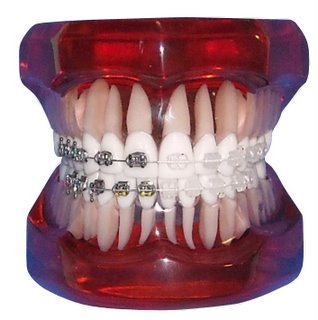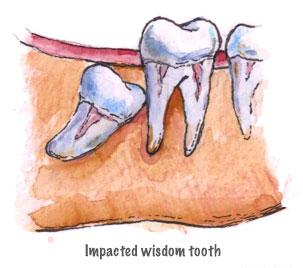Baby teeth, Teeth crowns, Oral bacterial and pneumonia
 This Beautiful Model can be a Wonderful motivational Tool for your patients , After seeing this model most patients opt for Ceramic Brackets. Note that archwire also is metal and tooth colored in each side of the arch, email today to order this model, icdr@hotmail.com
This Beautiful Model can be a Wonderful motivational Tool for your patients , After seeing this model most patients opt for Ceramic Brackets. Note that archwire also is metal and tooth colored in each side of the arch, email today to order this model, icdr@hotmail.comHow much a dental Crown should last ?
And that doesn't mean every five-year-old crown should be replaced, said Doyle C. Williams, the chief dental officer for DentaQuest, a national dental benefits company.
"Ten to 20 years is the average lifetime of a real crown," Williams said, noting that he has had one crown in his mouth for 35 years. Williams, who also sits on the board of the National Association of Dental Plans, said he thinks the industry standard should be extended. "It should be changed, because it encourages people to change [a crown] every five years," he said. More HERE
To Fill or Not to FILL Baby teeth ?
Professor Martin Tickle, of the University of Manchester, found no difference in the numbers of extractions for pain or infection whether baby teeth had been filled or not.
And when he surveyed the parents of all five-year-olds living in Ellesmere Port and Chester in 2003, he found only 6% would want their child to have a filling if they had symptomless decay in a baby tooth.
They are conventional drilling and filling, no fillings or a painless paint-on tooth treatment that merely seals and contains the decay.
Lead investigator Dr Gail Topping, of the University of Dundee, said: "This is a really big question to answer.
"At the moment there is no clear winner and we do not know which is best to recommend. More on BBC
Role of pathogenic oral flora in postoperative pneumonia following brain surgery
A matched cohort of 18 patients without postoperative lung complications was compared to 5 patients who developed pneumonia within 48 hours after brain surgery. Patients waiting for elective operation of a single brain tumor underwent dental examination and saliva collection before surgery. Bacteria from saliva cultures were isolated and periodontal disease was scored according to type and severity.
The number and severity of coexisting periodontal diseases were significantly greater in patients with postoperative pneumonia in comparison to the control group (p=0.031 and p=0.002, respectively). The relative risk of developing postoperative pneumonia in high periodontal score patients was 3.5 greater than in patients who had low periodontal score (p<0.0001).Full Paper
New Research may Bring Relief To 3.5 Million Denture Stomatitis (Oral Thrush) Sufferers
According to the most recent adult dental survey, 28 percent of the UK population wears dentures and a quarter of these are likely to develop denture stomatitis or fungal induced stomatitis (mainly Candida albicans), commonly known as oral thrush. This is a significant problem for denture wearers and is seemingly on the increase.
The Armourers & Brasiers Venture Prize, which is awarded annually in the form of an investment, enables the winner to engage in the early commercialisation of promising research and has been won by a team of scientists from the University of Liverpool. This team is led by senior lecturer and material scientist, Dr Rachel Williams, and senior lecturer in oral surgery, Dr Luke Dawson.
The project's idea is based on a cost effective nanoparticle silica coating which inhibits the adhesion and proliferation of cells and micro-organisms. Laboratory tests show that the nanoparticulate silica coating can inhibit the build up of virulent oral thrush (Candida albicans). More
Eastman Institute’s YanFang Ren, DDS, PhD, and his team determined that the effects of 6 percent hydrogen peroxide, the common ingredient in professional and over-the-counter whitening products, are insignificant compared to acidic fruit juices. Orange juice markedly decreased hardness and increased roughness of tooth enamel.
Unlike ever before, researchers were able to see extensive surface detail thanks to a new focus-variation vertical scanning microscope. “The acid is so strong that the tooth is literally washed away,” said Ren, whose findings were recently published in Journal of Dentistry. “The orange juice decreased enamel hardness by 84 percent.” No significant change in hardness or surface enamel was found from whitening. Full Report
Attending Dental Meeting is Fun if all follow IDS style
Our annual dental meeting exhibit floors are too boring! At IDS, many dental companies have built-in cafes at their booths that serve coffee, tea, soft drinks, fresh fruit, and even hors d'oeuvres. There were even sushi bars set up in a couple of the booths! At about 5 p.m., the place really starts rocking with live bands in many of the booths, and the drinks become a little more serious than Diet Coke. The reason is that these companies not only want dental professionals to visit their booths, they want them to stay longer so they can talk to them about their latest products. More HERE
Smoking Linked To Brain Damage
ScienceDaily (June 23, 2009) — New research which suggests a direct link between smoking and brain damage will be published in the July issue of the Journal of Neurochemistry. Researchers, led by Debapriya Ghosh and Dr Anirban Basu from the Indian National Brain Research Center (NBRC), have found that a compound in tobacco provokes white blood cells in the central nervous system to attack healthy cells, leading to severe neurological damage. More here
Align Technology loses verdict to Ormco over patent
Align Technology Inc., the maker of a product to straighten teeth, violated a patent belonging to Danaher Corp.'s Ormco's unit over its Invisalign, a federal jury said.
After judgment is entered, Ormco said it will be entitled to ask the court to bar Align from infringing the patent and to seek a royalty from all Align sales since January 2003 related to the Invisalign aligners. More Here
Two-thirds of American adults are too fat
Two-thirds of American adults are either obese or overweight, and the groups warned that the U.S. obesity epidemic could derail efforts by lawmakers to reform the nation's health system.
"Our health care costs have grown along with our waist lines," said Jeff Levi, executive director of Trust for America's health, which released the report along with the Robert Wood Johnson Foundation. Full Details


